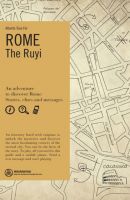The story of the magical sword Marco Polo stole from China continues in another city, a city at least as exceptional as Venice. It appears that over the centuries, the Ruyi changed hands many times, from popes to artists, from necromancers to prostitutes, from lords to commoners; each learned the history of this magical object and each hid it in a different place for a different reason The Ruyi reached Rome centuries ago; the city now bears so many signs of its passage that traditional Roman legends can be read in light of this incredible story. Carlo Dolfin, the old professor who learned of the affair in Venice, believes that the scepter came to Rome, but can no longer be recognized in its original form. That’s not all. Some documents he hastily recovered suggest that even the Roman Empire was rooted in the power of a magical object and that the strength of the Caesars declined when they lost track of it. He therefore suspects that the Chinese Ruyi could be a variation of that magical object from ancient Rome.
Alberto Toso Fei descends from an ancient family of glassmakers from the island of Murano. A journalist and an avid traveler, he has written four books that form an anthology of sorts on the mysteries of Venice and the lagoon. The most recent of the four, published by Studio LT2, is entitled The Secrets of the Grand Canal. The other three, which have also been translated into several languages including English, are: Venetian Legends and Ghost Stories, Venicenigma and Mysteries of the Lagoon and Witch Tales, published by Elzeviro. In his tales, Venice is a mosaic that gets put back together, piece by piece, to reveal the city’s mysterious soul. Digging deep into the past, Toso Fei takes the reader back to the dawn of a history thirteen centuries old. His work is anchored in rediscovering the more curious and fascinating sides of history, moving away from the usual places, away from the official history learned in textbooks. At the same time, through oral accounts he captures the aesthetic value of storytelling. With Shaul Bassi, Alberto wrote “Shakespeare in Venice”, a guide-book containing forty tales about the Serenissima, described through the eyes of Otello and Shylock.
